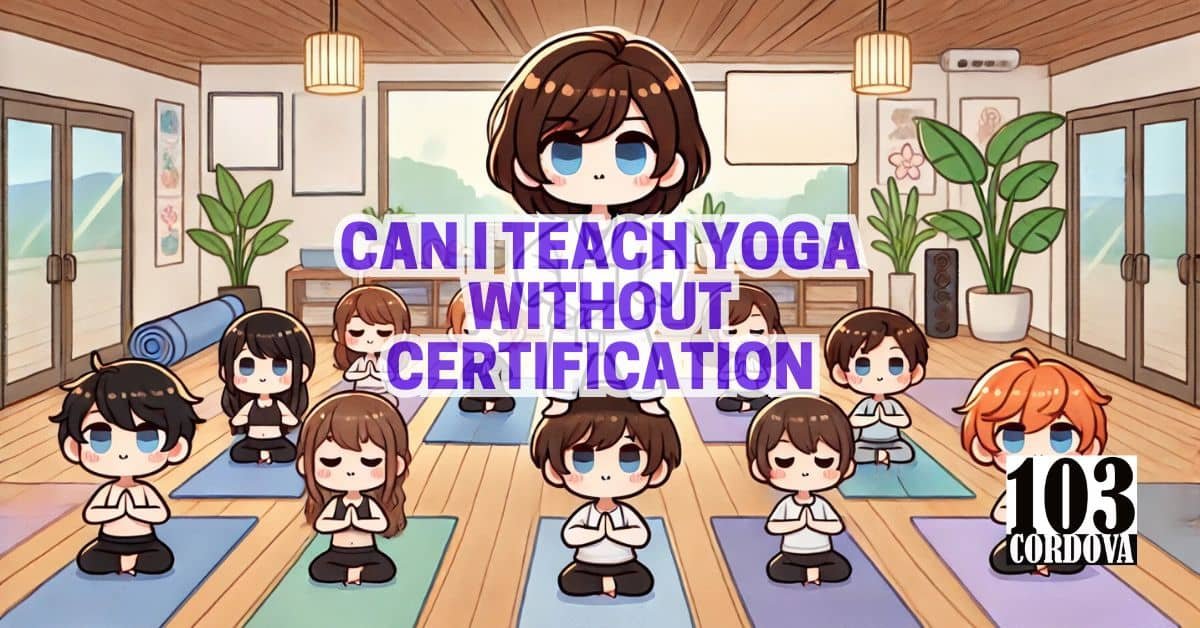Teaching yoga has become a popular pursuit for many passionate practitioners.
A common question people ask is, “Can I teach yoga without certification?”
We’ll explore the legal, ethical, and practical aspects of teaching yoga without formal certification in a straightforward way.
We will discuss the potential benefits and drawbacks of teaching without a certificate.
By the end, you should have a clearer understanding of whether or not you need certification to begin teaching yoga.
1. Are There Legal Requirements for Teaching Yoga Without Certification?
In most countries, including the Philippines, there are no specific legal requirements to teach yoga.
However, some studios and gyms may have their own rules, often requiring certification to maintain quality and safety standards.
It’s important to research local regulations and understand the policies of the places you plan to teach, as they may vary.
While the government may not require it, individual facilities often set their own expectations for teacher qualifications.
Understanding these requirements can help you decide where you can realistically offer yoga classes.
🧘 What Is Classical Yoga, and How Does It Differ from Modern Yoga?
2. Why Yoga Certification Is Important for Teaching Safely
Yoga certification ensures that you know proper techniques to guide your students safely through poses and breathing exercises.
It helps you understand different body types, modifications, and how to prevent injuries, which is key for every instructor.
Certified training also teaches you about contraindications for specific health conditions, which helps protect students with different needs.
Without certification, you may miss crucial training that ensures your students’ well-being and limits the chances of mistakes.
Proper knowledge and training mean students are less likely to get injured, leading to a more positive experience for everyone involved.
🧘 How Yoga for Mental Health Training Can Help Manage Stress and Anxiety
3. The Risks of Injury and Liability Without Proper Certification
Teaching yoga without certification comes with risks, especially when it comes to physical injury.
Without proper training, you may inadvertently suggest poses or adjustments that could harm someone, particularly those with preexisting conditions.
Liability issues can also arise, as students may hold you responsible for injuries if you lack formal qualifications and the skills to prevent harm.
Insurance companies often require certification to provide coverage, which is important if you plan on teaching professionally.
Understanding these risks can help you make an informed decision about whether teaching without certification is worth it.
🧘 Exploring the Surprising Benefits of Infrared Hot Yoga for Your Health
4. How Certification Builds Trust and Credibility with Students
Certification shows your students that you are knowledgeable and have completed proper training to become a yoga teacher.
Many people feel safer knowing their instructor has been through a structured program and understands how to guide them properly.
Trust and credibility are crucial in yoga, where students are often vulnerable both physically and emotionally, and certification can help establish this bond.
When students know their teacher is certified, they are more likely to follow instructions and attend classes regularly.
Building trust through certification can lead to long-term relationships with students, which helps both them and your teaching career.
🧘 How to Experience the Full Benefits of Hip-Opening Yoga: Tips and Techniques for Beginners
5, The Professional Benefits of Becoming a Certified Yoga Instructor
Being a certified yoga instructor can open doors to teaching opportunities in studios, fitness centers, and even wellness retreats.
Certification makes you more marketable, as studios prefer hiring instructors who can prove their skills and training.
It may also lead to higher pay rates, as certified instructors are often seen as more reliable and qualified.
Additionally, being certified can give you access to professional yoga networks and resources that uncertified teachers may miss out on.
These benefits can make a significant difference in how far you can advance your career as a yoga teacher.
🧘 The Life-Changing Benefits of Postnatal Yoga for New Moms
6. Is It Ethical to Teach Yoga Without Certification?
Some people wonder if it’s ethical to teach yoga without a certification.
This largely depends on your level of experience, knowledge, and intention when teaching others.
If you prioritize your students’ safety and well-being and are honest about your qualifications, it may be ethically acceptable to teach—though certification is still the best practice.
However, if you lack proper training and put students at risk, it could be seen as unethical to teach without certification.
Honesty, self-awareness, and a commitment to ongoing learning are key factors in determining whether it’s right to teach without formal credentials.
🧘 The Life-Changing Benefits of Yoga Teacher Training: Why You Should Consider It
7. Why Uncertified Teachers Are Still Popular in the Yoga Community
There are many uncertified teachers who are popular because of their deep personal experience and engaging personalities.
Some have practiced yoga for years and have learned from their own teachers in informal settings, which helps them build confidence and unique teaching styles.
Students are often drawn to instructors who have charisma and the ability to make them feel comfortable, regardless of their certification status.
However, popularity does not replace the need for safety training, which is a critical aspect of being a good yoga instructor.
It’s important for uncertified teachers to be aware of their limitations and seek education to improve their skills.
🧘 The Positive Impact of Yoga Classes for 11-Year-Olds on Mental and Physical Health
8. What Are the Alternatives to Formal Yoga Certification?
If certification is not an option for you, consider mentoring with an experienced yoga teacher who can guide you in a more informal but practical way.
You can also attend workshops, seminars, and short courses that deepen your understanding of yoga practices, anatomy, and teaching skills.
There are many online resources, books, and community classes that provide valuable learning opportunities.
While these alternatives are valuable, they may not carry the same weight as a formal certification when it comes to securing teaching positions in studios.
Regardless, self-study and mentoring can still help you build the skills necessary to teach effectively.
🧘 Can I Do Yoga and Exercise Together? How to Create a Complementary Fitness Plan
9. Understanding the Responsibility of Teaching Yoga Properly
Teaching yoga isn’t just about guiding poses—it involves understanding the physical, mental, and emotional needs of your students.
Without proper training, you might not be fully aware of how to assist different individuals safely or understand how each pose impacts the body.
Being responsible means knowing your limits and doing everything you can to avoid harming others, which includes ongoing education and understanding contraindications.
You also need to create a supportive environment where students feel comfortable expressing their concerns or asking questions.
Properly preparing yourself as a teacher means you are less likely to make errors that could cause harm.
10. How to Know If You’re Ready to Teach Yoga Without Certification
If you feel confident in your ability to guide others safely and have significant personal experience, you might feel ready to teach yoga.
However, it’s important to reflect on whether you have enough knowledge to adjust poses properly, prevent injuries, and answer students’ questions accurately.
Consider whether you can handle different levels of students, especially beginners who need more support and direction.
If you’re unsure about any of these responsibilities, seeking further education or certification is a wise choice.
Being ready means being honest about your abilities and taking responsibility for your students’ safety.
🧘 103 Cordova Yoga Classes Marikina
💡 Conclusion
Teaching yoga without certification is possible, but it comes with certain risks and responsibilities that should not be ignored.
To give your students the best experience and protect yourself from liability, certification is highly recommended.
Certification helps ensure that you can guide students safely, prevent injuries, and build a trusting environment for everyone involved.
While some uncertified teachers can still be successful, they need to make sure they have the experience and knowledge required to teach effectively.
Ultimately, the goal is to ensure a safe, enriching environment for everyone involved, whether you decide to get certified or not.
🧘 Our Services
Discover the transformative power of yoga at our serene studio, located at 103 Cordova Tower, Marquinton Residences, Cirma Street, Sto. Nino, Marikina City.
Our yoga classes cater to all ages and fitness levels, ensuring a welcoming and supportive environment for everyone.
Whether you seek flexibility, stress relief, or a deeper mind-body connection, our expert instructors are here to guide you every step of the way.
Reach us at 09176225780, connect with us on Facebook, or use our website’s contact form to book your class today.
Embrace your journey to wellness and balance—start your yoga practice with us now!

